Illiantia, the blue sun, appeared in the First Time on the eastern horizon as the smallest flicker of light, exactly as the Guardians had foretold, during the power of the God King Kemenketaph, which is now some twenty generations past. And as Illiantia grew ever larger over the passing ages, becoming even as the true Sun, he suddenly discarded his benign mask, causing many animals and plants to fall before his unseen power, never to rise again.
The Guardians knew that the time of the Judgement was near at hand, that Illiantia would soon strike at the Earth's heart and lay her waste. And so they instructed the priests to count the years from the time when Illiantia had first made his presence known in the eastern sky – 666 years they would count until the Judgement would once again be upon us. For, in truth, the wrath of the blue sun had been witnessed long ago in the Days of the Dawn, its deadly cycle written by the Creators of Arcadiatzl into the Great Pillars of Xhalir, the sacred knowledge of which had been entrusted to the Guardians for all time.
No one, however, could have imagined the fury that befell the Earth in those days. The ground had trembled many times before – but never like this. The city walls that had stood since before the time of the Flying Serpent, had fallen as though built of sand. Winds, the likes of which had never before been witnessed, blew away everything in their path, including the great Pillars of Xhalir – gone forever. And then the burning rocks began to rain from the heavens – their numbers greater even than the stars of creation. And the noise – a terrible thunder that tore the rocks assunder, multiplying their number a thousand times. There was no escaping this frightful fire and fury. The people tried but there was no place safe to shelter.
And still, as much as this terrible affliction had brought the people to their knees, beseeching the Gods of the Creation to spare them, the worst was yet to come. Illiantia would show no mercy to the sons of man. Without warning, the very stars of the stately heavens began to depart from their posts, slowly at first but then faster. They moved out of their places, turning and twisting, seeking new destinies and some falling forever into the depths of the ocean. And all at once, they steadied themselves and moved no more. For a brief moment, everything was quiet and still. But just as the surviving few believed his fury was spent, the waters came – the raging waters that had tumbled the whole Earth, crashed over the mountains and washed the last remnant of Arcadiatzl beneath the waves forever.
Three months of fire and fury and the entire Earth was laid waste. Countless more species of animals and plants had yielded to the mighty wrath and were no more. The few people that clung to life had little to live for. They had not prepared themselves for such anger from Illiantia and would suffer greatly for their penance.
In time the survivors would slowly begin to rebuild their world. However, that mankind had come so close to being removed from the face of the Earth was of great concern to the few Guardians that had survived the great inundation, saved from the Judgement in a great Ark they knew to build before the waters came. And so, they made haste to lay down their knowledge of Illiantia's wrath that future generations might benefit from it and prepare themselves for his certain return.
But with the Pillars of Xhalir having long been turned to dust, a new Codex of the Sacred Knowledge was prepared by the Guardians. In time – many generations after the Codex had been laid down – the sons of the Guardians would ensure the construction of this great codex, building new pillars that would hold within their very dimensions, the sacred knowledge of their forefathers. That the sons of sons should read the pillars and understand, then never again would mankind come so near to his end.
An Ancient Codex
Such might have been the scenario some 12,500 years ago when our ancient ancestors witnessed the first flickers of the hazy, bluish light of an explosion at the core of our galaxy. As the cosmic superwave reached the Earth, the initial effects of such an event would have our planet bombarded with all manner of radioactive particles, killing plants and animals by the millions. Hundreds of years later this devastation would be followed by a second wave of slower-moving cosmic debris, smashing into our planet, causing all manner of conflagrations and innundations. But it seems that our ancient ancestors were also aware of something much more worrying – the cyclical nature of such galactic core explosions and so they laid down this 'sacred knowledge' in a 'codex' – a plan – that later generations of their devastated civilisation would build. We see this 'codex' today as the Pyramids of Giza, built during the 4th Dynasty of the Ancient Egyptian civilisation. That such ancient plans were handed down from Arcadia is hinted at:
"The design of the structures that Imhotep raised for Djoser at Saqqara seems to hark back to a remote past, deliberately recalling the occasion of the 'First Time', when creation arose in the primeval marsh, to which Djoser would return on death." Reymonds, 'Mythical Origins of the Egyptian Temple', P96
"They (the temples) were built according to an architectural plan which was supposed to have been revealed in a codex that fell from the heavens at Saqqara in the days of Imhotep." Aldred 'The Egyptians', P32
If there did indeed exist an ancient Codex in the manner proposed by our scenario – and hinted at by the Ancient Egyptians themselves – and the Pyramids at Giza were the end result of such a Codex, (i.e. the new Pillars of Xhalir), how might the 'Guardians' have encoded their 'sacred knowledge' into these structures? How are we to 'read' the Giza Pyramids to recover its secrets? What follows is an interpretation of the Pyramids of Giza as a repository of just such ancient knowledge. This is not to detract from the possibility that the structures may also have been designed with a more practical purpose in mind, such as a 'seed vault' that would ensure the survival of crop diversity in the event of a natural disaster and to offer the survivors of such a calamity the chance to restart the growth of food crops that may otherwise have become extinct.
In planning their codex it seems logical to assume that the key information the Designers would wish to communicate to future generations would most likely consist of the following:
- The start date of the previous cycle (i.e. when Illiantia first appeared in the eastern sky).
- The date(s) of the cataclysm(s) (i.e. when the cosmic superwaves struck)
- The end date of the last cycle, when the Earth returned to relative peace.
- The number of years between the end of once cycle and the beginning of the next.
Intelligent Design
So, let us assume the ancient Designers met to decide how best to 'transmit' such knowledge far into the future. Someone suggests simply writing everything into clay tablets. This idea is quickly dismissed since the Designers realise that with so few people having survived the cataclysm, in all liklihood, mankind will lose much of what he had already learned, quickly reverting to a very primitive state. Finding food and shelter would be the priorities in the foreseeable future than reading and writing. It is expected also that the ability to read and write would be lost very quickly, as indeed would the language used in any such tablets and – in time – new languages would replace the old.
In any case, even if the language could somehow be preserved, such tablets could easily be destroyed or lost. The Designers reasoned that whatever 'design' they conceived, it would have to be big – very, very big. Greater even than the lost Pillars of Xhalir – such was the significance of the sacred knowledge and the importance of its durability and passage through time. The planned design had to be such that, when eventually built, it would last for all time in the hope that mankind would relearn his lost knowledge and be able to decode the sacred knowledge contained within the Codex. Before it was too late.
Of course, with so few people and resources, it was quite impractical for the Guardians to consider constructing the new Pillars themselves. This would have to be the task of future generations, using the 'sacred Codex' the Guardians would design and bequeath to them.
Another of the Guardians suggested that the Codex should utilise the 'language of mathematics' since – unlike narrative text or hieroglyphs – the language of mathematics remains inviolate, no matter how long the span of time. It cannot be misinterpreted.
This was agreed as was the importance of building into the design a 'beacon' or 'key' to its understanding. Such a beacon would signal to future civilisations the mathematical 'context' in which the completed design was to be considered.
The simplest beacon – to symbolise the mathematical nature of the Codex – would, naturally, be a number. But not just any random number. It would require a number that demonstrated 'intelligent design' – an abstract number that could be easily recognised by a mathematically astute future civilisation. The Designers knew of just such an abstract, 'intelligent number', formed from the ratio of a circle's circumference to its diameter. The division of this ratio would always give the first 3 digits of the resulting answer as 3 – 1 – 4 and these digits would be plainly encoded into the Codex in the hope that future civilisations would see the beacon and recognise its significance.
Of course, the added benefit of arranging the design in such a way as to incorporate the 3 – 1 – 4 mathematical beacon, is that such a number implies a circle and a circle is precisely what would be required to indicate the dates to be encoded into the Codex. By simply implying a circle much effort and resource is saved since this would only require a few strategically placed structures to be built as opposed to actually constructing a masive physical stone circle. The 3-1-4 beacon effectively would serve two purposes – it would act as a mathematical beacon of 'intelligent design' giving future generations the overall 'context' in which to consider the design, and it would also save much time and effort having to construct a massive, physical circle.
The Giza Precession Wheel (GPW)
That such a circle is implied around the structures at Giza can be seen in more detail here:
http://www.thegizaoracle.co.uk/Flash/GPW-Intelligent-Design.swf
This 'implied' or 'imaginery' circle the Designers provided would form their 'Precession Wheel'. They had determined long ago – through knowledge gained over countless generations – that the stars in the night sky were not as fixed as they might at first appear. If, for example, you look at a star on the horizon and noted its celestial co-ordinates and you then checked that same star's position on the same date 72 years later, you will have found that it will have moved from its original position by around 1 degree. Indeed, for that star to return to the celestial position you had recorded would take around 26,000 years.
The Designers would use this 'precessional motion' of the stars as the timing mechanism for their grand 'Precession Wheel'. Each degree around the imaginery wheel would constitute 72 years. By simply marking various points around the wheel it would be possible for them to record their important dates – past and future.
Of course, there is little point in marking specific points (i.e. dates) around the wheel without having a start point. This would be like trying to tell somone the time from an analogue clock which had no numbers on the face nor any indication as to whether the clock was properly orientated. Quite simply, you require at least one marker or reference point e.g. '12' on your clock face in order to even begin to know the clock's orientation and to tell the time. This is also the case for the Designer's Precession Wheel for it would essentialy operate like an analogue clock.
It seems this reference or start point has been provided for us by the positioning of the Great Sphinx – this is our '12 o'clock', our marker. So how can we determine the year (within our own time frame) the ancient Designers used as their start date, their "First Time"? They would most likely anticipate that future calendars would change or disappear as civilisations rise and fall, with no common time frame or reference date back to the days when the mighty cataclysm struck. Unless, of course, they were able to use the one time frame of reference that is universal to all ages and civilisations – the precessional motion of the stars.
The idea is quite simple. Choose a single star, record its azimuth (its horizontal position clockwise from north) just before the star is about to set on the horizon and then encode this data into the design. Such a measurement could have been made using a device similar to Crichton Miller's Celtic Cross. Future advanced civilisations would then be able to use this data to 'work back' when the star was at those co-ordinates, thereby giving the date when the star was positioned there, thus the reference or start point for the Precession Wheel.
Queens of Precession
However, there was a problem with this idea. If only one large structure was built depicting the chosen star, how would it be possible for future civilisations to be able to determine which star was being refered to? Looking up at the night sky, people of the future would simply wonder which of the tens of thousands of stars was being depicted. The problem is much the same if two large structures are built depicting two stars since a straight line can connect any two points. With three stars, however, the situation becomes a little better, especially if the three chosen stars form a relatively tight group. It would be important also that this group of stars should remain largely unaffected by the effects of the 'Proper Motion' of the stars, a phenomenon that distorts the spatial distances between stars over long periods of time, thus defeating the purpose of fixing their pattern on the ground that they would be correctly identified by a future civilisation. To this end the Designers decided the most practical group of three stars that would meet their needs were the tight group of 3 stars that form Orion's Belt.
There was a further problem, however, which quickly came to light. Even with 3 stars forming a fairly distinctive pattern within a tight group, the Designers realised that there existed numerous permutations of three stars in the night sky that could potentially match their design, thus erroneously regarded by a future civilisation as the correct triad. To avoid such confusion would require a decisive clue, a full-proof mechanism that would ensure future generations could not fail to select the correct 3-star group.
The most straightforward solution to this problem would be to somehow indicate within the design the prcessional motion of the chosen 3-star group over thousands of years. And, better still, this particular aspect of the design might also be utilised to encode the duration that would pass before the return of Illiantia – its cycle! It would seem that this detail (the precessional motion of the Orion Belt stars) is provided through the relative placement of the 2 sets of Queens Pyramids which depict the precessional motion of these 3 stars from one horizon to another over a period of around 13,000 years (figure 1).
It is worth noting that this idea might also explain the peculiar absence of the Queens pyramids of Khafre, who reputedly had five wives. Quite simply, the original function of these structures ws never intended as 'Queens Pyramids' but as precessional start and end markers for a particular group of stars, hence why there are no Queens Pyramids of Khafre. With this detail it seems quite certain then that it is the Orion Belt stars that the ancient Designers have depicted for us.
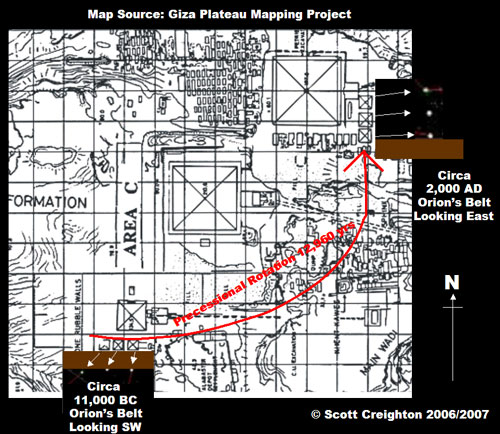
Figure 1 – The 2 Sets of 'Queens' depict the Precessional Motion of the Orion Belt Stars over almost 13,000 years
This idea can be viewed here as a Flash presentation:
http://www.thegizaoracle.co.uk/Flash/GOCT.swf
The Great Cycle of Cataclysm
Futhermore, it is quite possible that these structures might also be conveying to us the duration (in years) between Illiantia's cycles, thus:
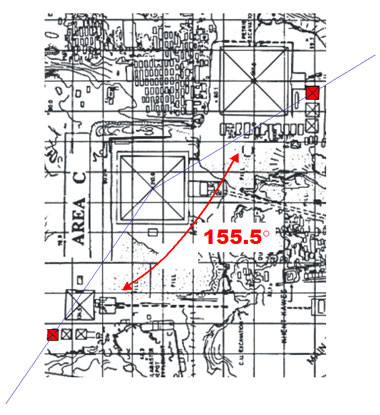
Figure 2 – The 2 Sets of 'Queens' encode the duration (in degrees) between Cycles
By measuring the angle between the two extreme apexes of the 2 sets of Queens Pyramids, we find that this is measured at 155.5°. We then convert this angle into actual years by multiplying by 72 which tells us that the duration from the end of one cycle to the beginning of the next is 155.5 x 72 = 11,196 years. We will discover shortly when the previous cycle ended which – by adding the duration of 11,196 years – will tell us when we can next expect Illiantia's return.
The 'Chosen Star' Calibrates the Wheel
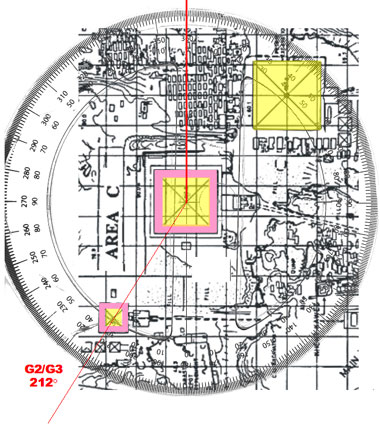
Figure 3 – Khafre/Menkaure Alignment from North = 212°
Having now selected an appropiate group of three stars, it would then be a simple matter of ensuring that the physical ground structures depicted the chosen star of the group of three (i.e. the star with which to apply the encoded celestial co-ordinates) in such a way that this structure stood out from the others. This could easily be done by simply misaligning the 'chosen pyramid' from the others or by making it larger or smaller than the others. It would then be apparent to a future civilisation – having discovered the encoded data – which pyramid the data is to be applied to.
And so, with a means of ensuring future civilisations could not fail to select the correct group of three stars and then the specific star from within the group of three (i.e. Mintaka), it was now a case of finding a simple means of encoding the chosen star's celestial azimuth into the design. By encoding the star's azimuth at the horizon, you are effectively registering a specific date. This could be done quite easily by arranging the Orion Belt stars in such a way that a line drawn from the centre of the design (Khafre's apex) through the apex of the chosen pyramid (Menkaure) – when measured clockwise from north – would record the correct azimuth. In the case of Menkaure we find this azimuth gives us 212° (figure 3).
Alas, however, when we input this data for the star Mintaka into our star-mapping program we find we have a possible date range between 10,400-11,000BC – not particularly accurate for the purposes of a callibrating date for the Precession Wheel. We need more information, some other marker that will help us considerably narrow the date range.
It is quite logical to assume that with such crucial information the Designers would have ensured that it would be signposted to us in their design. And it seems that this may indeed be the case. This signpost represents one of Giza's most enduring puzzles – the curious lines that run top to bottom of each face of Khufu and Menkaure which Egyptologists have long failed to explain. These lines essentialy bisect each face of these two pyramids, effectively making them 8-sided structures. These 'bisectors' are our clue to dating the Precession Wheel with greater accuracy for what they lead us to is the construction of a very unique (hidden) triangle around the 3 Great Pyramids and it is within this hidden triangle that the anceint Designers have encoded the additional information required to accurately date the start of their Precession Wheel.
In my previous article on the Graham Hancock Forum, I presented the Centroid Alignment Theory (CAT) which proposes that the three Great Pyramids at Giza were aligned within a great triangle (the Great Giza Triangle or GGT) using the three most ancient mathematical centroids: incentre, barrycentre and circumcentre (figure 4). You can see more detail on this here:
http://www.grahamhancock.com/forum/CreightonS1.php?p=3
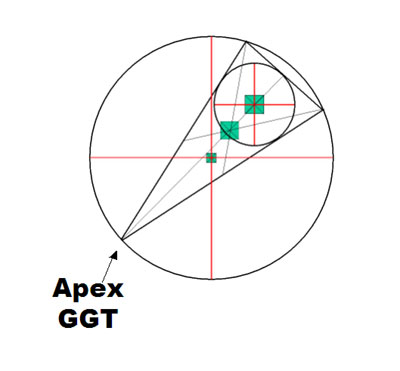
Figure 4 – The Great Giza Triangle (GGT) and its Apex (star)
Orion Rising
If we are to accept that the three pyramids at Giza are indeed symbolic of stellar objects, namely the Orion Belt stars, and that the centre or apex of those pyramids are symbolic of the centre of those stars, then what are we to make of the apex of the Great Giza Triangle (figure 4), that seems to indicate a point on the southwest horizon? If the apex of the pyramid represents the centre of the star it symbolises, is it not possible that the apex of the GGT might also allude to a star? If so, then which star? The answer to this question is logical, simple and encoded into the GGT (figure 5).
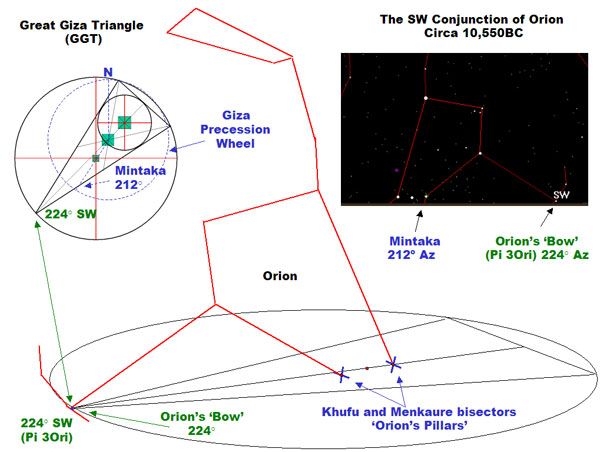
Figure 5 – Orion 'Points' to the 'Hidden Star' at 224° Az
Intriguingly, the bisectors we find built into the faces of Khufu and Menkaure lead us to construct a triangular design that inevitably creates an apex – i.e. a 4th star (Pi 3Ori, Orion's 'Bow' or 'Shield') – at 224° and it does so without the need to physically construct a 4th pyramid! Through the pyramid bisectors and the GGT, the design itself implies a 4th star.
The First Wave Strikes
Returning now to our star-mapping program, by ensuring that the star 'Pi 3Ori' is precisely placed on the southwest horizon at 224° with Mintaka fixed at 212°, we can now secure a more accurate date for the Giza Precession Wheel start point – 10,550BC (± 100 yrs). It would seem then that on this date some 12,500 years ago, the first flicker of a strange, blue star appeared in the eastern sky and soon after the first wave of destruction in the form of deadly radioactive particles afflicted the planet. However, it would take another 666 years for the full, cataclysmic effects of the second cosmic "superwave" to reach the Earth. How do we know of this duration? It is encoded into the Wheel!
With the calibrating date for the Giza Precession Wheel now known, determining the other dates encoded within the Wheel is now relatively straightforward. To ensure the design (and therefore its construction effort) was as economical as possible, the Designers would utilise the existing structures to impart this additional information. Through strategic placement of these structures they could encode these dates but still maintain the symbolic correlations with the Orion Belt stars. We find the dates are encoded thus:
The Second Wave Strikes
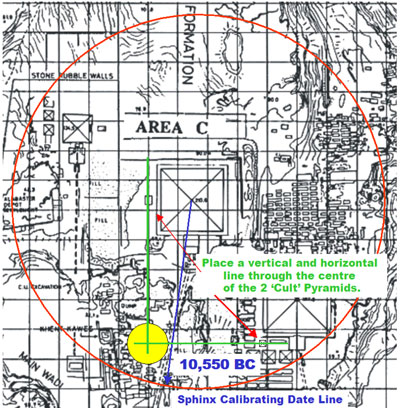
Figure 6a -The Intersection of the 'Cult' Pyramids Date the 2nd Great Cataclysm
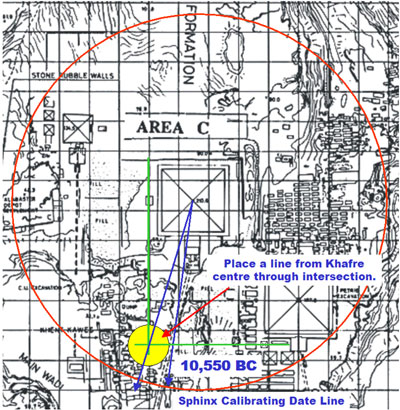
Figure 6b -The Intersection of the 'Cult' Pyramids Date the 2nd Great Cataclysm
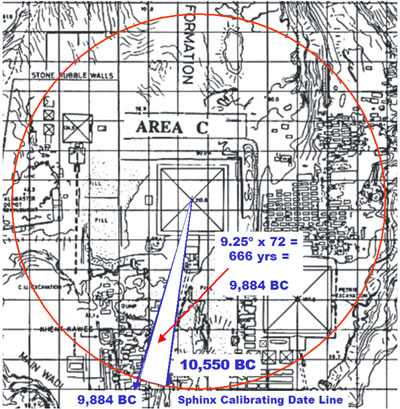
Figure 6c -The Intersection of the 'Cult' Pyramids Date the 2nd Great Cataclysm
The End of the Cycle
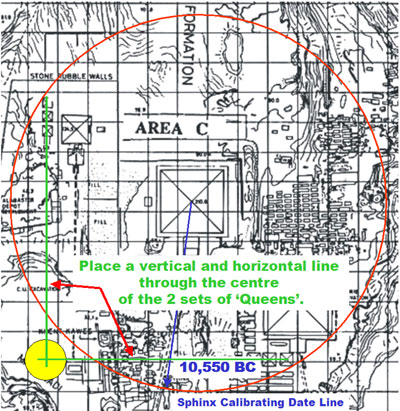
Figure 7a -The Intersection of the 'Queens' Pyramids Dates the End of the Cycle
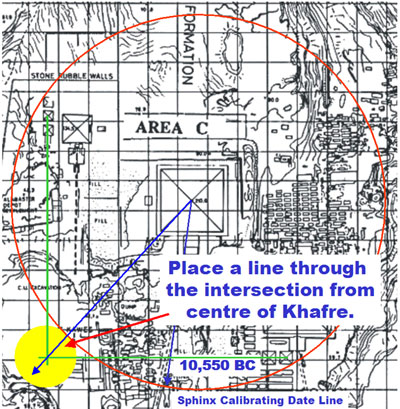
Figure 7b -The Intersection of the 'Queens' Pyramids Dates the End of the Cycle
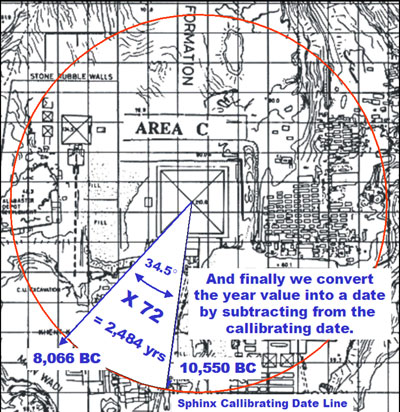
Figure 7c -The Intersection of the 'Queens' Pyramids Dates the End of the Cycle
I|t seems then that in the year, 8.066BC, the agent of the Earth's cycle of cataclysm – a cosmic superwave – finally passed and the Earth returned once more to times of relative peace.
What seems remarkable is that when one compares the scientific record back to these dates we find that they correspond with peaks of cosmic activity that is widely believed by scientists to have caused the exctinction of many animal and plant species around the world (circa 10,500BC) and then later around 9,800BC.
The Next Time
And so to the final question – when is this cycle next due? Since we now know the end date of the previous cycle (8,066BC) and the duration between the cycles (11,196 years – see figure 2), it is quite possible to then work out when the next cycle is due, i.e. the return of the Blue Sun, the next galactic core explosion, releasing its deadly cosmic superwave towards our planet.
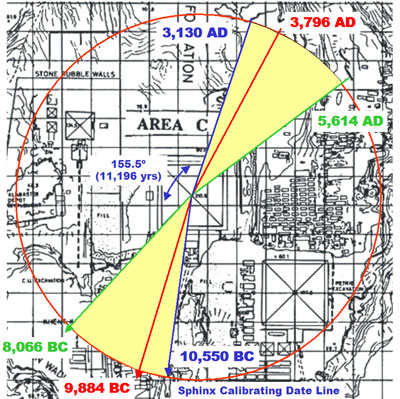
Figure 8 – Dating the Next Cycle
It seems then that the first flicker of the next Blue Sun (i.e. a galactic core explosion) will be seen in our skies around the year 3,130AD bringing with it a volley of deadly radiation and 666 years later (3,796AD) the second cosmic superwave – and all the debris that comes with it – will sweep over us. It seems that the year 3,796AD is our next date with destiny. What this will mean for our planet at that time is anyone's guess but it is unlikely to be anything good. One thing that is quite certain, however, is that long after the cosmic superwave has finally passed, it is quite likely that the Great Pyramids at Giza will still be standing, ready to pass on their warning to future generations of this deadly, cosmic cycle.
On a final note – the 16th century prophet, Nostradamus, allegedly correctly predicted many future events including, some say, the date of the end of the world. The truth of the matter is actually that Nostradamus's predictions simply end in the year 3,797AD – there are no more predictions from him beyond that year. Is it perhaps possible that we may now have found the reason why?
Article based on 'The Giza Oracle'
Author, Scott Creighton
Available from: http://www.lulu.com/content/307375
References
Hamlet's Mill – Giorgio De Santillana and Hertha Von Dechend
The Complete Pyramids – Mark Lehner
The Cycle of Cosmic Catastrophes: Firestone, West & Warwick-Smith
Earth Under Fire – Dr Paul LaViolette
Civilisation One – Christopher Knight and Alan Butler
The Orion Mystery – Robert Bauval and Adrian Gilbert
23.5 Degrees – Gary Osborn (http://www.freewebs.com/garyosborn/235degrees.htm)
When the Sky Fell – Rand and Rose Flem-Ath
Fingerprints of the Gods – Graham Hancock
The Golden Thread of Time– Crichton E M Miller
The Giza Plateau Mapping Project





